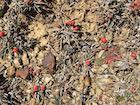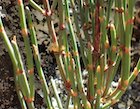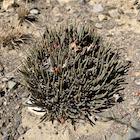Ephedra rupestris
Benth. 1846
Common names
Munika, pincu-pincu, sanu-sanu, saro-saro [local Spanish]; 厄阿麻黄 [Chinese].
Taxonomic notes
Syn. Ephedra americana var. rupestris (Benth.) Ball; Ephedra andina var. humilis (Wedd.) Parl.; Ephedra humilis Wedd. Molecular analysis has found E. rupestris, E. triandra and E. tweediana to comprise a basal clade sister to a larger clade that includes all other South American species of Ephedra (Rydin and Korall 2009).
Description
Plants low, depressed or even prostrate, but to 0.6 m tall, forming dense cushions. Branches strict, erect; leaves reduced to sheaths; aments typically peduncled but usually sessile or subsessile; bracts 5-7, red or white, more or less fleshy; seeds included or exserted. Flowers from March to May. (Bell and Bachman 2011, Macbride 1936 based on Stapf's 1889 description of E. americana var. rupestris).
Herbarium sheet scan at SEINet, accessed 2022.12.30.
Distribution and Ecology
Ecuador, Peru, Bolivia, and Argentina (Tucumán, Salta, and Jujuy). Grows at 1900-4600 m elevation in grassy páramo with rocky outcrops in windswept areas, growing in gravelly or sandy soil. Also found in grassy areas and associated with cushion plants, bunch grass, cactus, lichen and composites (Bell and Bachman 2011).
The species is not of conservation concern, being widely distributed and not currently subject to any recognized threats. The status of the Argentine populations is uncertain, however (Bell and Bachman 2011).
Remarkable Specimens
No data as of 2023.03.03.
Ethnobotany
No data as of 2022.12.30.
Observations
See the observations on iNaturalist, accessed 2022.12.30. Those observations suggest that access is particularly easy near the Laguna de Limpiopungo in Ecuador and around Cotopata National Park in Bolivia. Bell and Bachman (2011) also mention its occurrence in the Salinas y Aguada Blanca National Reserve in Peru.
Remarks
The epithet rupestris means "rock-dwelling".
Citations
Bell, A. and S. Bachman. 2011. Ephedra rupestris. The IUCN Red List of Threatened Species 2011: e.T201681A9163757. https://dx.doi.org/10.2305/IUCN.UK.2011-2.RLTS.T201681A9163757.en, accessed 2022.12.30.
Bentham, G. 1846. Plantas Hartwegianas imprimis Mexicanas, p. 253. Available: Biodiversity Heritage Library, accessed 2021.12.31.
Macbride, J. F. 1936. Ephedraceae, Flora of Peru. Publ. Field Mus. Nat. Hist., Bot. Ser. 13(1/1):84–86. Available: Biodiversity Heritage Library, accessed 2022.12.30.
Rydin, C., and P. Korall. 2009. Evolutionary relationships in Ephedra (Gnetales), with implications for seed plant phylogeny. International Journal of Plant Sciences 170(8):1031–1043. doi:10.1086/605116.
Stapf, O. 1889. Die Arten der Gattung Ephedra. Denkschrift der Kaiserlichen Akademie der Wissenschaften, Mathematisch-Naturwissenschaftliche Klasse 56(2):1–112. Available: Biodiversity Heritage Library, accessed 2022.12.30.
See also
Hunziker, J. H. 1949. Sinopsis de las especies Argentinas del género Ephedra. Lilloa 17: 147–174. As of the end of 2022, this issue of Lilloa is not yet available online, but it likely contains a better description of the species.
Species profile at Plants of the World Online, accessed 2022.12.30.




